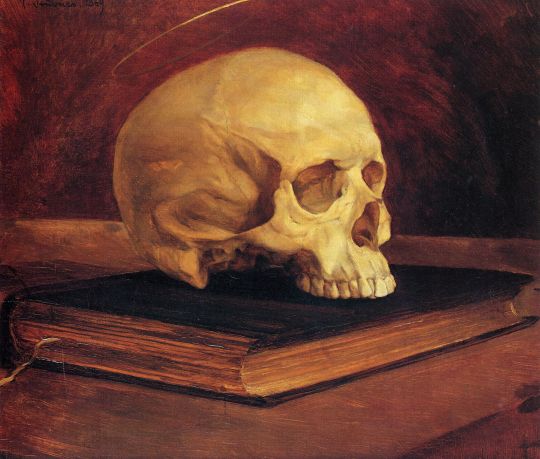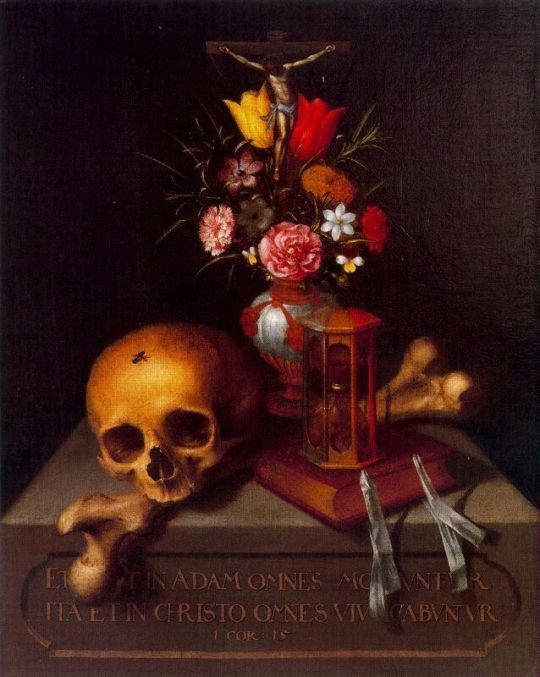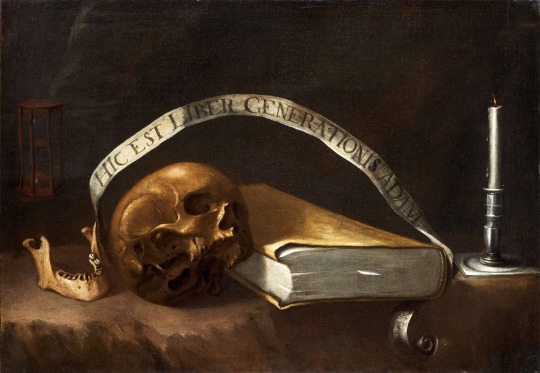#Tomás Yepes
Explore tagged Tumblr posts
Text

Tomás Yepes (Spanish, 1595 or 1600 – 1674)
Dulces y frutos secos sobre una mesa, 1642-1674, Museo Nacional del Prado
12 notes
·
View notes
Text






Vanitas:
Maria Margaretha van Os, 1862.
2. Wilhelm Trübner, 1869.
3. N.L. Peschier, 1660.
4. Tomás Yepes, 17th c.
5. Juan Francisco Carrión, 1650.
6. Haec Sola Virtus, c. 1650.
#Maria Margaretha van Os#Wilhelm Trübner#N.L. Peschier#Tomás Yepes#Juan Francisco Carrión#Haec Sola Virtus#vanitas
6 notes
·
View notes
Text

Still Life with Perseus, Andromeda and the Dragon of Poseidon Tomás de Yepes or Hiepes (1595-1674, Spanish)
#dianthus#carnation#fruits#figurative painting#figurative art#mythological art#mythological painting#Perseus and Andromeda#17th century art#17th century painting#spanish art#Tomás de Yepes#Tomás de Hiepes
17 notes
·
View notes
Text
I happened to come upon a painting that somewhat illustrates what the inside of my head is like: Still Life with Perseus, Andromeda and the Dragon of Poseidon - Tomás Yepes

Everything's kind of messy but highly detailed, hey nice look there's bunnies, fruit, other fruit, flowers, other flowers - wait shit is that a fucking dragon. Anyway yeah the composition is lovely and the foreground is focused on pretty, lovely and frivolous things, while there's some chaotic batshit bullshit apparently going on in the background but we're not paying attention to that rn.
251 notes
·
View notes
Text

Tomás de Yepes or Hiepes (Spanish, 1595 or 1600-1674) • Still Life with Sweets • 17th century
#art#painting#still life#fine art#baroque still life#baroque art#spanish baroque#art of the still life blog#spanish painter
23 notes
·
View notes
Text

Tomás Yepes (Valencia, h. 1610 – 1674) Bodegón en un paisaje (sandía) h. 1650-1660 óleo sobre lienzo 72,2 x 108,8 cm Nº inv. P02138 Colección BBVA España
Compañero de Bodegón en un paisaje (granadas), es obra importante en la producción del artista, también conocido como Tomás Hiepes, muy bien conservada y desconocida hasta 2001, fecha en que fue identificada por Alfonso E. Pérez Sánchez. Para afianzar el mensaje cristiano derivado de la Contrarreforma, cobró importancia la inclusión en las composiciones de elementos que con su simbología reforzaban el sentido de la imagen. Para el profano resultaba atrayente a la vista, y para el iniciado la lectura de los objetos representados permitía ir más allá de lo evidente. El conjunto de todos los elementos incluidos en la escena puede sugerirnos la redención de las almas. La primera pareja, Adán y Eva, simbolizados en las frutas a la izquierda de la composición, cometen el pecado original desobedeciendo a Dios al comer el fruto del árbol prohibido, condenando así a la humanidad. Sin embargo, con la venida del Mesías, Jesucristo, con su Pasión y muerte simbolizadas en las espinas a la izquierda y la vid a la derecha, se redimen las almas. Asimismo, Jesús trae consigo la fundación de una nueva Iglesia fecunda y próspera (la sandía y el maíz), en contraposición a la Sinagoga (la rama de higuera caída), como instrumento primordial para alcanzar la salvación al final de los tiempos, en la Jerusalén celeste. Cabe destacar la presencia en la composición de las mencionadas mazorcas de maíz, por no ser estas habituales en los bodegones españoles, ya que su cultivo se introduce en la Península muy avanzado el siglo XVI. El fondo de paisaje adquiere en este lienzo mayor relevancia que en su compañero, gracias al desarrollo de una vista arquitectónica. Este tipo de bodegones, frecuentes en la pintura napolitana, fueron modelo en la pintura valenciana del XVIII.
Información e imágenes de la web de la Colección BBVA.
2 notes
·
View notes
Text

Bodegón, Tomás Yepes, 1668
#art#art history#Tomas Yepes#still life#bodegon#Baroque#Baroque art#Spanish Baroque#Spanish art#17th century art#Prado#Prado Museum#Museo del Prado
71 notes
·
View notes
Text




Tomás Yepes (Born: 1595 or 1600, Died: 1674, aged 78-79 or 73-74), Spain.
0 notes
Text


Tomás de Yepes or Hiepes (1595 or 1600 –1674) Spanish painter in the Kingdom of Valencia. An artist of the Baroque movement, he worked as a painter of still life and bodegón—still life paintings depicting pantry items.

Terracota Vase with an Orange Bush by Tomas Hiepes (1595/1600-1674), oli on canvas
36 notes
·
View notes
Text

Tomás Yepes (1595-1674) Our Lady of the Forsaken (Virgin of the Innocents), ca. 1660.
30 notes
·
View notes
Text

Tomás Yepes (Spanish, 1595 or 1600 – 1674)
Frutero de Delft y dos floreros, 1642, Museo Nacional del Prado
#Tomás Yepes#tomas yepes#spanish#17th century#still life#fruit#flowers#Museo Nacional del Prado#madrid
7 notes
·
View notes
Text

Tomás Yepes (Spanish, 1595 or 1610–1674), Still Life with Grapes, 1674. Oil on canvas.
85 notes
·
View notes
Photo

Tomás Yepes (b. ca. 1600–1674)
Sugared fruits and pastries on a parcel-gilt plate, a decorated Manises jar, a glass fountain, wooden boxes and a búcaro, on a wooden ledge
27 notes
·
View notes
Text

Four Circular Still Lifes, ca. 1649 Tomás de Yepes (Hiepes) (Spanish)
#dianthus#carnation#painting#still life#flowers#fruits#samhain#17th century art#17th century painting#spanish art#Tomás de Yepes#Tomás de Hiepes
26 notes
·
View notes
Photo

Still Life with Basket of Pomegranates Bowl of Pears ,Chestnuts, Chili and Cherries - Tomás Yepes
Spanish, 1595-1674
OIl om canvas, 95 x 81 cm
165 notes
·
View notes
Text
This painting or others like it may have inspired Madeline von Foerster.
Nuestra Señora de los Desamparados de Valencia - Tomás Yepes - 1644

48 notes
·
View notes